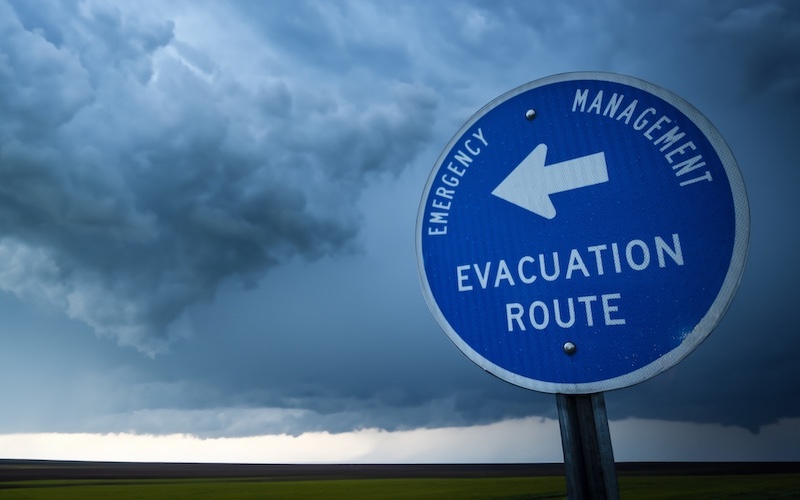
Recent extreme weather events show us that there is no place to hide from climate change. Photo: Shutterstock
For a while, people talked about “climate havens.” These were places where “climate migrants” fleeing rising seas, wildfires, scorching heat, and monster hurricanes could supposedly recapture the relative serenity of the before times —before, that is, our changing climate began to routinely wreak so much havoc. In 2022, one associate professor of real estate pointed to Asheville, North Carolina, and Burlington, Vermont, as two places where people might go to escape the worst effects of climate change.
Well, maybe not. Asheville got torn to shreds by Hurricane Helene this month. Catastrophic wind and torrential rain from the ferocious storm killed more than 230 people, erasing homes and highways like chalk on a blackboard. Thousands were left without power or drinking water. This year and last, heavy downpours in Burlington and across Vermont led to similar cataclysmic flooding. Even now, some Vermont businesses are still struggling to recover.
There’s a lesson in all this, and it’s a simple one: There is no haven from climate change. Like a B-movie horror film, we might run from the boogieman to locales we think are safe, but the scale and magnitude of climate change are so great that, sooner or later, the boogieman will get us.
Our only recourse now is to take our heads out of the sand and work to do something about it.
A Climate Haven That Wasn’t
Anna Jane Joyner, founder and director of Good Energy, has been trying to do something about it. She consults with screenwriters on depicting climate change accurately in TV and film. She aims to improve public understanding of climate change, hoping that the world will be moved to cut back on the carbon pollution causing the chaos. But even Joyner, a climate-literate professional who splits her time between the Gulf Coast and Los Angeles, confessed in a recent Los Angeles Times article how surprised she was to see a powerful hurricane ravage her hometown in North Carolina’s mountains. To her mind, Asheville was far safer than California, besieged by fires, droughts, and heatwaves. And safer, too, than the hurricane-prone Gulf Coast.
Similarly, Michelle Medeiros, a climate activist for over 20 years, moved to North Carolina from the Netherlands in 2022 to be near her mother. Before the move, she did her homework, comfortable that the town her family chose near Asheville would remain relatively insulated from climate upheaval.
“I did the research,” she says. “I read the climate mitigation plans. I looked at climate maps to see what the potential impacts would be. I was trying to make a home that would give us that sense of security and peace in what’s to come as tumultuous times.”
After Helene hit, Medeiros lost that sense of security and peace, along with the power, water, and internet connection– all down for a week. Luckily, her house is intact, and her family is safe, but she describes the destruction around her as “horrifying” and “astounding.”
“It’s not supposed to happen here,” she says. “Mud and water rising the way it did, that doesn’t happen here. That happens on the coast.”
Nowhere is Immune
Hurricane Helene dumped 50% more rain than it ordinarily would on North Carolina because of climate change. And in Vermont, Washington County—home to Montpelier—is now tied for being the second-most disaster-prone county in America. That’s according to the think tank Rebuild by Design, which counted the number of federal disaster declarations from 2011 through 2023. The research of others backs that up. According to Jonathan Winter, a geography professor at Dartmouth College, the Northeast now sees 50% more extreme precipitation than before 1995. His finding is supported by the federal government’s Fifth National Climate Assessment.
Scientists know that global warming’s impacts are widespread and interconnected because we live in one interconnected ecosystem.
“No place is truly untouched by climate change anywhere in the world, Dave Reidmiller, director of the Gulf of Maine Research Institute’s Climate Center, told ABC News.
Reining In Climate Change
If colossal hurricanes, torrential downpours, massive wildfires, and persistent heat waves haven’t sent the message about climate change, what more will it take?
By now, we know what we should be doing. Ditching fossil fuels could make a real difference. Turning to clean energy to heat and cool our homes and businesses, strengthening aging public transit systems so fewer people need cars, and trading gas-guzzling cars for electric ones are all pieces of the puzzle. We can’t turn back the clock on climate change, but we can prevent our weather from worsening.
The other half of the puzzle comes in adjusting to our new climate reality. Our towns and cities should be working to prepare for the future and deal with the present. Utility infrastructure, like power lines, poles, and substations, must be built to withstand flooding and high winds. Permeable pavement on streets and sidewalks can help control flooding. More parks and green spaces can give water more places to flow. More street trees can shield city streets from intense heat. Our homes should be built specifically with climate in mind, outfitted with green roofs and insulation, perhaps elevated to avoid flooding. And when there are obvious places we shouldn’t be building – places prone to wildfire or hurricanes –let’s not build there.
And if there’s one more thing we should be doing, it’s this: Let’s put to rest the notion that there’s any haven from climate change. We live on one planet, and we live on it together. There’s no way to avoid the hard work ahead of us. We can’t outrun climate change.
.



